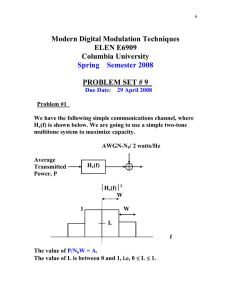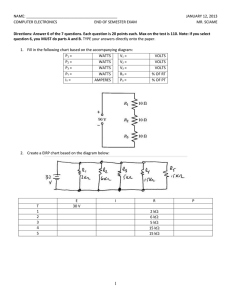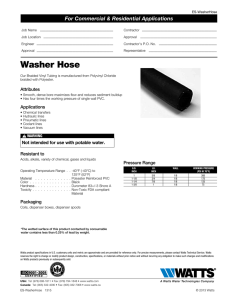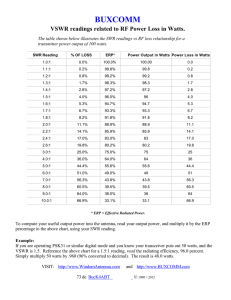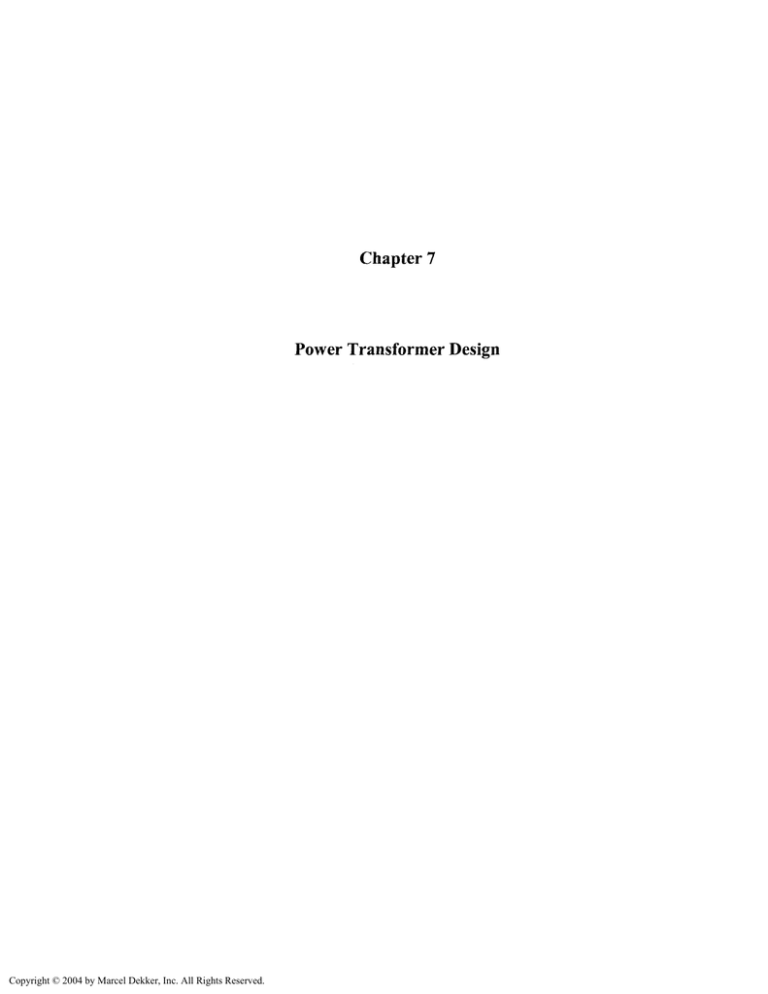
Chapter 7
Power Transformer Design
Copyright © 2004 by Marcel Dekker, Inc. All Rights Reserved.
Table of Contents
1. Introduction
2.
The Design Problem Generally
3.
Power-Handling Ability
4. Output Power, P0, Versus Apparent Power, Pt, Capability
5. Transformers with Multiple Outputs
6.
Regulation
7. Relationship, Kg, to Power Transformer Regulation Capability
8. Relationship, Ap, to Transformer Power Handling Capability
9. Different Cores Same Area Product
10. 250 Watt Isolation Transformer Design, Using the Core Geometry, Kg, Approach
11. 38 Watt 100kHz Transformer Design, Using the Core Geometry, Kg, Approach
Copyright © 2004 by Marcel Dekker, Inc. All Rights Reserved.
Introduction
The conversion process in power electronics requires the use of transformers and components that are
frequently the heaviest and bulkiest item in the conversion circuit. They also have a significant effect upon
the overall performance and efficiency of the system. Accordingly, the design of such transformers has an
important influence on the overall system weight, power conversion efficiency and cost. Because of the
interdependence and interaction of parameters, judicious tradeoffs are necessary to achieve design
optimization.
The Design Problem Generally
The designer is faced with a set of constraints that must be observed in the design on any transformer. One
of these constraints is the output power, P0, (operating voltage multiplied by maximum current demand).
The secondary winding must be capable of delivering to the load within specified regulation limits.
Another constraint relates to the minimum efficiency of operation, which is dependent upon the maximum
power loss that can be allowed in the transformer.
Still another defines the maximum permissible
temperature rise for the transformer when it is used in a specified temperature environment.
One of the basic steps in transformer design is the selection of proper core material. Magnetic materials
used to design low and high frequency transformers are shown in Table 7-1. Each one of these materials
has its own optimum point in the cost, size, frequency and efficiency spectrum. The designer should be
aware of the cost difference between silicon-iron, nickel-iron, amorphous and ferrite materials. Other
constraints relate to the volume occupied by the transformer and, particularly in aerospace applications, the
weight, since weight minimization is an important goal in today's electronics. Finally, cost effectiveness is
always an important consideration.
Depending upon the application, certain ones of these constraints will dominate. Parameters affecting
others may then be traded off as necessary to achieve the most desirable design. It is not possible to
optimize all parameters in a single design because of their interaction and interdependence. For example, if
volume and weight are of great significance, reductions in both can often be affected, by operating the
transformer at a higher frequency, but, at a penalty in efficiency. When the frequency cannot be increased,
reduction in weight and volume may still be possible by selecting a more efficient core material, but, at the
penalty of increased cost. Thus, judicious trade-offs must be affected to achieve the design goals.
Transformer designers have used various approaches in arriving at suitable designs. For example, in many
cases, a rule of thumb is used for dealing with current density. Typically, an assumption is made that a
good working level is 200 amps-per-cm2 (1000 circular mils-per-ampere).
Copyright © 2004 by Marcel Dekker, Inc. All Rights Reserved.
This will work in many
Table 7-1 Magnetic Materials
Magnetic Material Properties
Material
Trade
Initial
Flux Density
Typical
Name
Name
Permeability
Tesla
Operating
Composition
Hi
Bs
Frequency
Silicon
3-97 SiFe
1500
1.5-1.8
50-2k
Orthonol
50-50 NiFe
2000
1.42-1.58
50-2k
Permalloy
80-20 NiFe
25000
0.66-0.82
lk-25k
Amorphous
2605SC
1500
1.5-1.6
250k
Amorphous
2714A
20,000
0.5-6.5
250k
Amorphous
Nanocrystalline
30,000
1.0-1.2
250k
Ferrite
MnZn
0.75-15k
0.3-0.5
10k-2M
Ferrite
NiZn
0.20-1. 5k
0.3-0.4
0.2M-100M
instances, but the wire size needed to meet this requirement may produce a heavier and bulkier transformer
than desired or required. The information presented in this volume makes it possible to avoid the use of
this assumption and other rules of thumb, and to develop a more economical design with great accuracy.
Power-Handling Ability
For years manufacturers have assigned numeric codes to their cores; these codes represent the powerhandling ability. This method assigns to each core a number that is the product of its window area, Wa, and
core cross-section area, Ac, and is called the area product, Ap.
These numbers are used by core suppliers to summarize dimensional and electrical properties in their
catalogs. They are available for laminations, C-cores, pot cores, powder cores, ferrite toroids, and toroidal
tape-wound cores.
The regulation and power-handling ability of a core is related to the core geometry, Kg. Every core has its
own inherent, Kg. The core geometry is relatively new, and magnetic core manufacturers do not list this
coefficient.
Copyright © 2004 by Marcel Dekker, Inc. All Rights Reserved.
Because of their significance, the area product, Ap, and core geometry, Kg, are treated extensively in this
book. A great deal of other information is also presented for the convenience of the designer. Much of the
material is in tabular form to assist the designer in making trade-offs, best-suited for his particular
application in a minimum amount of time.
These relationships can now be used as new tools to simplify and standardize the process of transformer
design. They make it possible to design transformers of lighter weight and smaller volume, or to optimize
efficiency, without going through a cut-and-try, design procedure.
While developed especially for
aerospace applications, the information has wider utility, and can be used for the design of non-aerospace,
as well.
Output Power, P0, Versus Apparent Power, Pt, Capability
Output power, P0, is of the greatest interest to the user. To the transformer designer, the apparent power, Pt,
which is associated with the geometry of the transformer, is of greater importance. Assume, for the sake of
simplicity, that the core of an isolation transformer has only two windings in the window area, a primary
and a secondary. Also, assume that the window area, Wa, is divided up in proportion to the power-handling
capability of the windings, using equal current density.
The primary winding handles, P^, and the
secondary handles, P0, to the load. Since the power transformer has to be designed to accommodate the
primary, P^, and, P0, then,
By definition:
Pr=P.n+Po, [watts]
P
m =~>
n
[watts]
[7-1]
The primary turns can be expressed using Faraday's Law:
The winding area of a transformer is fully utilized when:
By definition the wire area is:
,
/
r
,.
[7-4]
Copyright © 2004 by Marcel Dekker, Inc. All Rights Reserved.
Rearranging the equation shows:
[7-5]
Now, substitute in Faraday's Equation:
" "
AcBaJK\J
Rearranging shows:
-, [cm4]
acf f
*«/•'*/*„
B
JK K
[7_ 7 ]
U
The output power, P0, is:
P,=V,f,,
[watts]
[7.g]
The input power, Pj,,, is:
P"• = Ff / P', [watts]
-, m
L
J r[7-9]
Then:
^ = ^ + P o , [watts]
[7-10]
Substitute in, Pt:
WaAc =
P(l0 4 )
^ '—, [cm4] [7-11]
By definition, Ap, equals:
Ar=WaAc,
[cm4]
[7-12]
Then:
*,= /',,/„ > t cm4 ] t7-133
Copyright © 2004 by Marcel Dekker, Inc. All Rights Reserved.
The designer must be concerned with the apparent power, Pt, and power handling capability of the
transformer core and windings. P, may vary by a factor, ranging from 2 to 2.828 times the input power, Pjn,
depending upon the type of circuit in which the transformer is used.
If the current in the rectifier
transformer becomes interrupted, its effective RMS value changes. Thus, transformer size is not only
determined by the load demand, but also, by application, because of the different copper losses incurred,
due to the current waveform.
For example, for a load of one watt, compare the power handling capabilities required for each winding,
(neglecting transformer and diode losses, so that Pjn = P0) for the full-wave bridge circuit of Figure 7-1, the
full-wave center-tapped secondary circuit of Figure 7-2, and the push-pull, center-tapped full-wave circuit
in Figure 7-3, where all the windings have the same number of turns, (N).
Figure 7-1. Full-Wave Bridge Secondary.
The total apparent power, Pt, for the circuit shown in Figure 7-1 is 2 watts.
This is shown in the following equation:
P,=Pin+Po, [watts]
[7.14]
P,=2Pin, [watts] [7-15]
CR1
n
^
'2
'
CR2
I0
J .
1
Figure 7-2. Full-Wave, Center-Tapped Secondary.
Copyright © 2004 by Marcel Dekker, Inc. All Rights Reserved.
o—*
Figure 7-3. Push-Pull Primary, Full-Wave, Center-Tapped Secondary.
The total power, Pt, for the circuit shown in Figure 7-2, increased 20.7%, due to the distorted wave form of
the interrupted current flowing in the secondary winding. This is shown in the following equation:
P,=Pin+P0j2,
[watts]
[?_
P, =Pin(\ +72), [watts]
16]
[7-17]
The total power, Pt, for the circuit is shown in Figure 7-3, which is typical of a dc to dc converter. It
increases to 2.828 times, Pin, because of the interrupted current flowing in both the primary and secondary
windings.
P,=Pinj2+P042,
P,=2Pinj2,
[watts]
[watts]
[7_
[7-18]
19]
Transformers with Multiple Outputs
This example shows how the apparent power, Pt, changes with a multiple output transformers.
Output
Circuit
5 V @ 10A
center-tapped Vj = diode drop = 1 V
15 V@ 1A
full-wave bridge V^ = diode drop = 2 V
Efficiency = 0.95
Copyright © 2004 by Marcel Dekker, Inc. All Rights Reserved.
The output power seen by the transformer in Figure 7-4 is:
P 01 =(5 + 1)(10), [watts]
P0} = 60,
[watts]
And:
Po2=(r02+r<)(la,)> [watts]
P 0 2 =(15 + 2)(1.0), [watts]
P02=17, [watts]
[7.21-j
PI
CR1
-*- Io
t |
CR2
y
V
Pi
o
^
1
o
$ Rr
Figure 7-4. Multiple Output Converter.
Because of the different winding configurations, the apparent power, Pt, the transformer outputs will have
to be summed to reflect this. When a winding has a center-tap and produces a discontinuous current, then,
the power in that winding, be it primary or secondary, has to be multiplied by the factor, U. The factor, U,
corrects for the rms current in that winding. If the winding has a center-tap, then the factor, U, is equal to
1.41. If not, the factor, U, is equal to 1.
For an example, summing up the output power of a multiple output transformer, would be:
[7-22]
Copyright © 2004 by Marcel Dekker, Inc. All Rights Reserved.
Then:
P 2 =60(1.41) + 17(1), [watts]
/ > = 101.6, [watts]
[1-2?,]
After the secondary has been totaled, then the primary power can be calculated.
P +P
p
^-£l
P, =
(60)
/
(0.95)
, L[wattsJ
Pm=8l, [watts]
[7-24]
Then, the apparent power, Pt, equals:
P,=Pin(u) + P,, [watts]
/?=(81)(1.41) + (101.6), [watts]
/ > = 215.8,
[watts]
[?.25]
Regulation
The minimum size of a transformer is usually determined either by a temperature rise limit, or by allowable
voltage regulation, assuming that size and weight are to be minimized. Figure 7-5 shows a circuit diagram
of a transformer with one secondary.
Note that a = regulation (%).
Secondary
Primary
n = NJ1SL
=1
s P
Figure 7-5. Transformer Circuit Diagram.
Copyright © 2004 by Marcel Dekker, Inc. All Rights Reserved.
The assumption is that distributed capacitance in the secondary can be neglected because the frequency and
secondary voltage are not excessively high. Also, the winding geometry is designed to limit the leakage
inductance to a level, low enough, to be neglected under most operating conditions.
Transformer voltage regulation can now be expressed as:
V (N.L.)-K(F.L.), ,
a = - ^\-V-(100),
t%]
I/ frj T \
V
/'
V
FL
° ( ' ->
[7-26]
L
J
in which, V0(N.L.), is the no load voltage and, V0(F.L.), is the full load voltage. For the sake of simplicity,
assume the transformer in Figure 7-5, is an isolation transformer, with a 1:1 turns ratio, and the core
impedance, Re, is infinite.
If the transformer has a 1 : 1 turns ratio, and the core impedance is infinite, then:
7
/n=/0>
[amps]
With equal window areas allocated for the primary and secondary windings, and using the same current
density, J:
= / „ * „ = A F, =/„/?„
[volts]
[7 _ 2g]
Regulation is then:
AK
\V
a=—^(100) + —^(100), [%]
s
p
[7-29]
Multiply the equation by currents, I:
'p'b
','0
[7_30]
Primary copper loss is:
Secondary copper loss is:
^ = A K s / o , [watts]
Copyright © 2004 by Marcel Dekker, Inc. All Rights Reserved.
[7.32]
Total copper loss is:
P C U = P P + P S , [watts]
[?_33]
Then, the regulation equation can be rewritten to:
a =^-(100), [%]
P
°
[7-34]
Regulation can be expressed as the power lost in the copper. A transformer, with an output power of 100
watts and a regulation of 2%, will have a 2 watt loss in the copper:
Pc cu=^-, [watts]
" 100
[7-35]
(100)(2)L
Pru='-^- , [watts]
100
[7-36]
p
cu =2' twatts] [7-37]
Relationship, Kg, to Power Transformer Regulation Capability
Although most transformers are designed for a given temperature rise, they can also be designed for a given
regulation. The regulation and power-handling ability of a core is related to two constants:
a =•
P.
2K K
* *
[7-38]
a = Regulation (%) [7-39]
The constant, Kg, is determined by the core geometry, which may be related by the following equations:
WAlK,
K = " c » , [cm5]
MLT
Copyright © 2004 by Marcel Dekker, Inc. All Rights Reserved.
[7-40]
The constant, Ke, is determined by the magnetic and electric operating conditions, which may be related by
the following equation:
Where:
Kf = waveform coefficient
4.0 square wave
4.44 sine wave
From the above, it can be seen that factors such as flux density, frequency of operation, and the waveform
coefficient have an influence on the transformer size.
Relationship, Ap, to Transformer Power Handling Capability
Transformers
According to the newly developed approach, the power handling capability of a core is related to its area
product, Ap, by an equation which may be stated as:
4
P(l0
)
l
'
'
, [cm4]
Where:
Kj~ = waveform coefficient
4.0 square wave
4.44 sine wave
From the above, it can be seen that factors such as flux density, frequency of operation, and the window
utilization factor, Ku, define the maximum space which may be occupied by the copper in the window.
Different Cores Same Area Product
The area product, Ap, of a core is the product of the available window area, Wa, of the core in square
centimeters, (cm2), multiplied by the effective, cross-sectional area, Ac, in square centimeters, (cm2), which
may be stated as:
Ar=WaAc,
Copyright © 2004 by Marcel Dekker, Inc. All Rights Reserved.
[cm4]
[y _ 43]
Figures 7-6 through Figure 7-9 show, in outline form, three transformer core types that are typical of those
shown in the catalogs of suppliers.
A
c
D
Figure 7-6. Dimensional Outline of a C Core.
.
i
Wa
i
E
.«—
i
G
D
Figure 7-7. Dimensional Outline of a El Lamination.
OD
Figure 7-8. Dimensional Outline of a Toroidal Core.
Copyright © 2004 by Marcel Dekker, Inc. All Rights Reserved.
A
c
w
a
\
\
JL
j
s
L
A
B
ip
\
c
PQ Ferrite Core
Figure 7-9. Dimensional Outline of a PQ Ferrite Core.
250 Watt Isolation Transformer Design, Using the Core Geometry, Kg, Approach
The following information is the Design specification for a 250 watt isolation transformer, operating at 47
Hz, using the, Kg, core geometry approach. For a typical design example, assume with the following
specification:
1. Input voltage, Vin
= 115 volts
2. Output voltage, V0
= 115 volts
3. Output current, I0
= 2.17 amps
4. Output power, P0
= 250 watts
5. Frequency, f
= 47Hz
6. Efficiency, TI
= 95%
7. Regulation, a
= 5%
8. Operating flux density, Bac
= 1.6 tesla
9. Core Material
= Silicon M6X
10. Window utilization, Ku
= 0.4
11. Temperature rise goal, Tr
= 30°C
Step No. 1 Calculate the transformer apparent power, P(
— + 1 I, [watts]
P=250\
{0.95
P,=513, [watts]
Copyright © 2004 by Marcel Dekker, Inc. All Rights Reserved.
[watts]
Step No. 2 Calculate the electrical conditions, Ke
Kf = 4.44, [sine wave]
Ke = 0.145(4.44)2 (47 )2 (1.6)2 (lO 4 )
* =1.62
Step No. 3 Calculate the core geometry, Kg.
[cm ]
*•-•£? '
^=31.7, [cm5]
Step No. 4 Select a lamination from Chapter 3, comparable in core geometry, Kg.
Lamination number
El-150
Manufacturer
Thomas and Skinner
Magnetic path length, MPL
22.9 cm
Core weight, Wtfe
2.334 kilograms
Copper weight, Wtcu
853 grams
Mean length turn, MLT
22 cm
Iron area, Ac
13.8 cm2
Window area, Wa
10.89 cm2
Area product, Ap
150 cm4
Core geometry, Kg
37.6 cm5
Surface area, A,
479 cm2
Step No. 5 Calculate the number of primary turns, Np using Faraday's Law.
N =—^
'
Np
—, [turns]
KfBaJAc
(4.44)(1.6)(47)(13.8)'
Nf = 250, [turns]
Copyright © 2004 by Marcel Dekker, Inc. All Rights Reserved.
Step No. 6 Calculate the current density, J.
J =
^(io 4 )—,
[amps/cm' ]
KfKuBaJAp
513(l0 4 )
J = ~,
r; rr^—rr—^
7, [amps/cm 1
(4.44)(0.4)(1.6)(47)(150)
J = 256, [amps/cm2]
Step No. 7 Calculate the input current, !„,.
7 , , = - , [amps]
V
in>l
25
°
'
r
i
[amps]
4=2.28, [amps]
Step No. 8 Calculate the primary bare wire area, Awp(B).
_4
,
J
=
(2.28)
»/>(*) ~
256
^
' Lcm
4^=0.0089, [cm2]
Step No. 9 Select the wire from the Wire Table, in Chapter 4.
4^=0.00822, [cm2]
4^=0.00933, [cm2]
cm
= 209,
[micro-ohm/cm]
Step No. 10 Calculate the primary resistance, Rp.
cm,
tfp=(22)(250)(209)(lO-6),
Rp =1.15,
Copyright © 2004 by Marcel Dekker, Inc. All Rights Reserved.
[ohms]
I,
[ohms]
[ohms]
Step No. 1 1 Calculate the primary copper loss, Pp.
Pp =(2.28) 2 (1.15), [watts]
P ;) =5.98, [watts]
Step No. 12 Calculate the secondary turns, Ns.
.
-
vin
ioo '
[turns]
(250)(115)(
5 ^
Ns=\ . A . ' 1 + - , [turns]
(115) t IOOJ
Ns = 262.5 use 263, [turns]
Step No. 13 Calculate the secondary bare wire area, Aws(B).
J'
.(2.17)
256
AwsB
[cm2]
s(B} = 0.00804,
Step No. 14 Select the wire from the Wire Table, in Chapter 4.
A
«P(B) = 0.00822, [cm2]
4^=0.00933, [cm2]
cm
= 209, [micro-ohm/cm]
Step No. 15 Calculate the secondary winding resistance, Rs.
6
Rs =MLT(^)| — |(lO"
),
^ cm J v
'
[ohms]
/? s =(22)(263)(209)(lO- 6 ), [ohms]
/?,=!. 21, [ohms]
Step No. 16 Calculate the secondary copper loss, Ps.
P,=llR,, [watts]
P S =(2.17) 2 (1.21),
^=5.70,
Copyright © 2004 by Marcel Dekker, Inc. All Rights Reserved.
[watts]
[watts]
Step No. 17 Calculate the total primary and secondary copper loss, Pcu.
pcu = Pt> + ps,
[watts]
Pcu=5.98 + 5.1, [watts]
/>,„=! 1.68, [watts]
Step No. 18 Calculate the transformer regulation, a.
a =^(100), [%]
o
(11.68)
<*=-, r
(250)
a = 4.67, [%]
Step No. 19 Calculate the watts per kilogram, W/K. Use the equation for this material in Chapter 2.
WIK = 0.000557 (f)
(Bac)
1.86
1.51 /. ,\1 86
WIK = 0.000557 (47)' 5 ' (1.6)
= 0.860
Step No. 20 Calculate the core loss, Pfe.
Pfe=(W/K)(Wtfe)(lO-}),
[watts]
P /e =(0.860)(2.33), [watts]
Pfe = 2.00, [watts]
Step No. 21 Calculate the total loss, Ps.
PZ =(11.68) + (2.00), [watts]
Pz= 13.68, [watts]
Step No. 22 Calculate the watts per unit area, y.
p
y = —, [watts/cm2]
4
w = ^ ' / , [watts/cm2 ]
(479)
^ = 0.0286,
Copyright © 2004 by Marcel Dekker, Inc. All Rights Reserved.
[watts/cm2]
Step No. 23 Calculate the temperature rise, Tr.
7>450(0.0286) (0826) ,
Tr = 23.9, [°C]
Step No. 24 Calculate the total window utilization, Ku.
K =A,,,
(263)(0.00822)
K = ^-- ---'- = 0. 199
(10.89)
-
N
=
(250)(0.00822)
= ^0.189
un=~-7^-x""
(10.89)
K
Ku =(0.189) + (0.199)
K,, = 0.388
Copyright © 2004 by Marcel Dekker, Inc. All Rights Reserved.
38 Watt 100kHz Transformer Design, Using the Core Geometry, Kg, Approach
The following information is the design specification for a 38 watt push-pull transformer, operating at
100kHz, using the Kg core geometry approach. For a typical design example, assume a push-pull, fullwave, center-tapped circuit, as shown in Figure 7-4, with the following specification:
1. Input voltage, V(min)
= 24 volts
2. Output voltage #1, V(oi,
= 5.0 volts
3. Output current #1,1(0|)
= 4.0 amps
4. Output voltage #2, V(o2)
= 12.0 volts
5. Output current #2,1(o2)
= 1.0 amps
6. Frequency, f
= 100kHz
7. Efficiency, r|
= 98%
8. Regulation, ot
= 0.5%
9. Diode voltage drop, Vd
= 1.0 volt
10. Operating flux density, Bac
= 0.05 tesla
11. Core Material
= ferrite
12. Window utilization, Ku
= 0.4
13. Temperature rise goal, Tr
= 30°C
14. Notes:
Using a center-tapped winding, U = 1.41
Using a single winding, U = 1.0
At this point, select a wire so that the relationship between the ac resistance and the dc resistance is 1:
The skin depth, E, in centimeters, is:
6.62
TT
E= i
6.62
=,
y 100, ooo
[cm ]
s = 0. 0209 , [cm]
Copyright © 2004 by Marcel Dekker, Inc. All Rights Reserved.
Then, the wire diameter, DA\VG> is:
0^=2(0.0209), [cm]
DAlva= 0.0418, [cm]
Then, the bare wire area, Aw, is:
(3.1416)(0.0418)2
, '[cm2]
Aw=±-^4 =0.00137, [cm2]
From the Wire Table 4-9 in Chapter 4, number 27 has a bare wire area of 0.001021 centimeters. This will
be the minimum wire size used in this design.
If the design requires more wire area to meet the
specification, then the design will use a multifilar of #26. Listed Below are #27 and #28, just in case #26
requires too much rounding off.
Wire AWG
Bare Area
Area Ins.
Bare/Ins.
ufi/cm
#26
0.001280
0.001603
0.798
1345
#27
0.001021
0.001313
0.778
1687
#28
0.0008046
0.0010515
0.765
2142
Step No. 1 Calculate the transformer output power, P
P0 = Pol+Po2, [watts ]
P,i=I0^oi + Vd}
/ > „ , = 4(5+1)
Pol =24,
[watts ]
[watts ]
Po2 =I02^o2+Vd},
P02 = 1(12 + 2)
Po2=14,
Copyright © 2004 by Marcel Dekker, Inc. All Rights Reserved.
[watts ]
[watts ]
[watts]
P 0 =(24 + 14)
P0 =38,
[watts]
[watts ]
[watts ]
Step No. 2 Calculate the total secondary apparent power, Pts.
P,s=PKoi+P,so2, [watts]
^,=24(1.41), [watts]
/L, =33.8, [watts]
P«o*=P,*(U),
[watts]
^ 0 2=14(1), [watts]
^2 =14, [watts]
^=(33.8 + 14),
[watts]
pa = 47.8, [watts]
Step No. 3 Calculate the total apparent power, Pt.
Ptp = PinPa, [watts ]
Pt =P,P+Pts,
[watts ]
.8,
Pt =102.5,
[watts ]
[watts ]
Step No. 4 Calculate the electrical conditions, Ke
K , = 4. 0,
[square wave ]
Ke =0.1 45 (4.0)? (100000 )?(0.05) 2 (lO" 4 )
Ke =5800
Step No. 5 Calculate the core geometry, Kg.
K g =——,
2Kea
g
(102.5)
2(5800)0.5'
K =0.0177,
Copyright © 2004 by Marcel Dekker, Inc. All Rights Reserved.
[cm 5 ]
L
[cm 5 ]
When operating at high frequencies, the engineer has to review the window utilization factor, K u , in
Chapter 4. When using a small bobbin ferrites, use the ratio of the bobbin winding area to the core window
area is only about 0.6. Operating at 100kHz and having to use a #26 wire, because of the skin effect, the
ratio of the bare copper area to the total area is 0.78. Therefore, the overall window utilization, Ku, is
reduced.
To return the design back to the norm, the core geometry, Kg, is to be multiplied by 1.35, and
then, the current density, J, is calculated, using a window utilization factor of 0.29.
Kg = 0.0177 (1.35)
K g = 0.0239,
[cm 5 ]
[cm5]
Step No. 6 Select a PQ core from Chapter 3, comparable in core geometry Kg.
Core number
PQ-2020
Manufacturer
TDK
Magnetic material
PC44
Magnetic path length , MPL
4.5 cm
Window height, G
1.43 cm
Core weight, W(fe
15 grams
Copper weight, W(cu
10.4 grams
Mean length turn, MLT
4.4 cm
Iron area, AC
0.62 cm2
Window area, Wa
0.658cm2
Area product, A
0.408 cm4
Core geometry, K
0.0227 cm5
Surface area, A(
19.7 cm2
Millihenrys per 1000 turns, AL
3020
Step No. 7 Calculate the number of primary turns, Np, using Faraday's Law.
Kf acJ
B AfAc '
K B
Np =
N
Copyright © 2004 by Marcel Dekker, Inc. All Rights Reserved.
(4.0 XO. 05 )(100000 X°-62 )'
= 19,
[turns ]
Step No. 8 Calculate the current density, J, using a window utilization, Ku = 0.29.
J
[amps / c m ]
= KfKuif BacJ
n f A
'
A
p
102.5(l0 4 )
(4. 0X0.29X0. 05X100000 )(0.408)'
J =433,
[amps / c m 2 ]
Step No. 9 Calculate the input current, !;„.
<-«
38
(24X0.98)'
/,.„ = 1.61,
[amps ]
Step No. 10 Calculate the primary bare wire area, Awp(B).
(1.61X0.707)
[cm 2 ]
'-,
Step No. 11 Calculate the required number of primary strands, Snp.
/I
C
_
f D\
r V^)
np
~ #26
0.00263
" ~ 0.00128
p
Step No. 12 Calculate the primary new ^0 per centimeter.
(new)//L2 / cm =
(new) wQ / cm =
//Q/cm
1345
2
(new)//Q / cm = 673
Copyright © 2004 by Marcel Dekker, Inc. All Rights Reserved.
Step No. 13 Calculate the primary resistance, Rp.
6
(icr
) [ohms]
v
'
Rp =(4. 4X19X673 ^lO'6)
Rp= 0.0563,
[ohms]
[ohms]
Step No. 14 Calculate the primary copper loss, Pp.
Pp =I2pRp,
[watts ]
Pp =(1.61^(0.0563)
Pp =0.146,
[watts ]
[watts ]
Step No. 15 Calculate the secondary turns, N sl .
sl
1
v.m 'V
100
V s] = V0+ Vd,
Vsl=5+l,
Vsl=6,
• " ',
[turns ]
[volts]
[volts]
[volts]
""»'
Nsl =4.77 use 5,
[turns ]
Step No. 16 Calculate the secondary turns, Ns2.
N „¥,
Vs2=12+2,
V s2 = 14,
[volts]
[volts ]
1+
0.5
Tbo-
r
[turns]
N J2 =11.1 use 1 1 , [turns ]
Copyright © 2004 by Marcel Dekker, Inc. All Rights Reserved.
Step No. 17 Calculate the secondary bare wire area, A wsl .
A
of
max
[cm2 ->]
r
,
(4XQ. 707)
/) v r a l =0.00653 ,
2
[cm 2 ]
Step No. 18 Calculate the required number of secondary strands, Sns|.
0.00653
" ~ 0.00128
Jl
•5,,, = 5 . 1 use 5
Step No. 19 Calculate the secondary, S[ new uQ per centimeter.
ns 1
(new )/jQ.I cm =
1345
(new ),uQ / cm = 269
Step No. 20 Calculate the secondary S] resistance, R s) .
6
Rsl =(4.4)(5)(269)(l0^ 6 ),
Rs} = 0.0059,
), [ohms]
[ohms]
[ohms]
Step No. 21 Calculate the secondary copper loss, Psl.
P,\=ti\R,i,
[watts]
psl = (4. 0)2 (0.0059)
ps , = 0. 0944 ,
Copyright © 2004 by Marcel Dekker, Inc. All Rights Reserved.
[watts ]
[watts ]
Step No. 22 Calculate the secondary bare wire area, Aws2.
AWS2=-^,
[cm 2 ]
, [cm 2 ]
Aws2= 0.00231,
[cm 2 ]
Step No. 23 Calculate the required number of secondary strands, SnS2.
"s2
#26
0.00231
0.00128
5M2=1.8use 2
Step No. 24 Calculate the secondary, S2 new ufi per centimeter.
,
, „ ,
uQ. I cm
(new )//Q / cm = —ns
1345
(new )/uQ. I cm = —-
(new )fJ.Q. I cm = 673
Step No. 25 Calculate the secondary, S2 resistance, Rs2.
RS2 = MLT (N, ,)
(10 -6 )
V cm J x
'
RS2 = (4.4X1 0(673 )(lO-6)
/?,2 = 0. 0326 ,
[ohms ]
[ohms]
[ohms ]
Step No. 26 Calculate the secondary, S2 copper loss, Ps2.
p
S2
= fs2^s2,
[watts ]
P J2 =(1.0)? (0.0326),
Ps2 =0.0326,
Copyright © 2004 by Marcel Dekker, Inc. All Rights Reserved.
[watts ]
[watts]
Step No. 27 Calculate the total secondary copper loss, Ps.
Ps = Ps] +Ps2, [watts ]
Ps =0.0944 +0.0326,
Ps =0.127,
[watts ]
[watts ]
Step No. 28 Calculate the total primary and secondary copper loss, Pcu.
Pcu =Pp+Ps,
[watts ]
Pcu =0.146 +0.127,
Pcu =0.273,
[watts]
[watts ]
Step No. 29 Calculate the transformer regulation, ex.
a =-£HL(IOO)
[%]
"o
[%]
a =0.718,
[%]
Step No. 30 Calculate the milliwatts per gram, mW/g. Use the equation for this material in Chapter 2.
mW / g = '
mW I g = 0.000318 (lOOOOO )'' 51 (0.05 f47
mW / g = 3.01
Step No. 31 Calculate the core loss, Pfe.
Pje =(mW I g^Wtfe )(l(r3)
P / e =(3.0lXl5)(lO- 3 )
Pfe =0.045,
[watts ]
[watts ]
[watts ]
Step No. 32 Calculate the total loss, Pz.
Pi. = PCU + Pfe ,
[wattS ]
P£ = (0.273 )+ (0.045 ) [watts ]
Pz =0.318,
Copyright © 2004 by Marcel Dekker, Inc. All Rights Reserved.
[watts ]
Step No. 33 Calculate the watts per unit area, \\i.
p
if/=—— , [watts / c m 2 ]
(0.318
,
,
(19.7)
Y
y = 0.0161,
n
[watts
/cm 1
L
[watts / c m 2 ]
Step No. 34 Calculate the temperature rise, Tr.
7>450(</) (o - 826) ,
[°C]
r r =450(0.016l) ( ° 8 2 6 ) , [°C]
TV = 14.9, [°C]
Step No. 35 Calculate the total window utilization, Ku.
T
(10)(5)(0.00128)
= v A / v---i = 0.0973
"'
(0.658)
al
(11)(2)(0.00128)
= ^ V —v-- = 0.0428
(0.658)
_
*
(38X2X000,28)
(0.658)
A:U =(0.148) + (0.0973 + 0.0428)
AT.. = 0.288
Copyright © 2004 by Marcel Dekker, Inc. All Rights Reserved.


